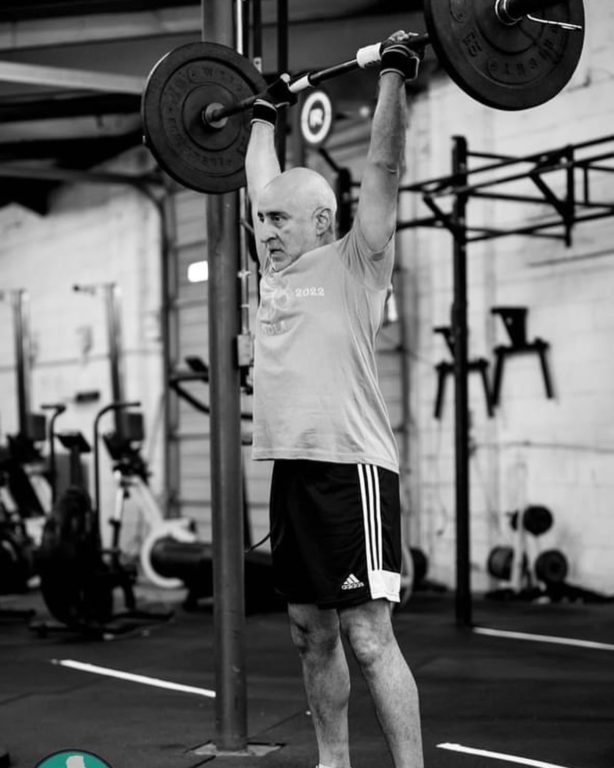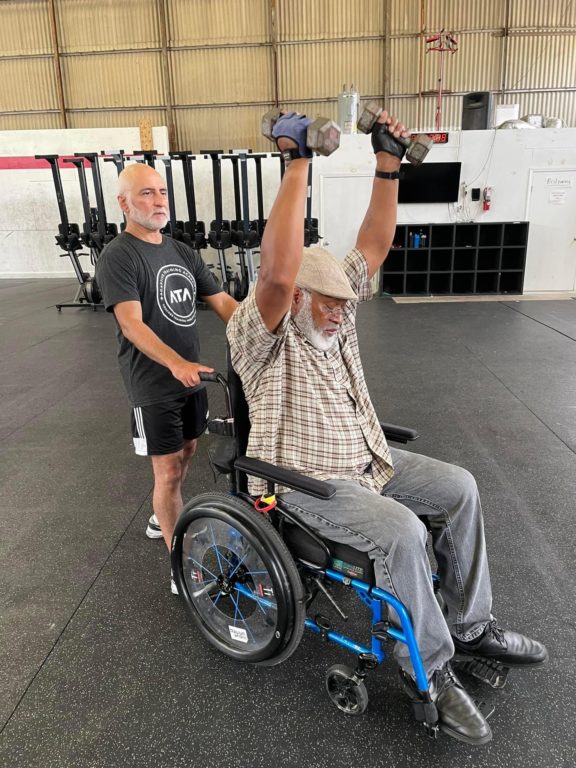It was the end of March 2016, the final week of that year’s CrossFit Games Open, and Carl Arredondo was elbows-deep in the CrossFit Games website.
“I’m a big CrossFit geek,” the 59-year-old said.
As he clicked through articles showcasing all the CrossFit community had accomplished over five weeks of fitness, one story stood out. A young basketball star, Kelsey Whirley, had lost her sport and her dreams to retinitis pigmentosa (RP), a genetic degenerative disease causing loss of vision.
Whirley described missing passes on the court and driving through red lights, unable to see objects in her periphery.
“That happens to me,” Arredondo thought as he read.
Whirley also shared how she modifies CrossFit workouts, drawing chalk lines on the dark gym mats and wrapping her medicine ball in brightly colored tape.
“And I have to do that, too,” Arredondo continued, pondering. He made an appointment with his ophthalmologist, followed by months of subsequent testing and second opinions.
By the end of the year, it was official: Arredondo had RP.

“If you want results, intensity is necessary. … In practice, this looks like consistently pushing a bit harder than you might want to or getting more than a little uncomfortable.”
“I believe the ethos can be best understood by examining CrossFit’s prescription and the values that have very naturally developed out of it — values that have come to characterize CrossFit and the CrossFit community. These values include things like results, personal responsibility and accountability, belonging, humility, camaraderie, service, integrity and excellence, work ethic and discipline, resilience and grit, humility, and virtuosity.”
Arredondo has always loved the weather. As a child, he’d gaze out the window watching rain fall and lightning flash.
He recalled the day a meteorologist visited his sixth-grade classroom.
“And from that day on, I knew I wanted to be a meteorologist,” he said.
The Texas native enjoyed a nearly three-decades-long career working for TV stations in Atlanta, Georgia, and New Orleans, Louisiana. He served as chief meteorologist for WWL-TV in New Orleans for 27 years before RP forced him into early retirement.
But before that, Arredondo developed a new passion: CrossFit.
It started in 2014 on the treadmill in a typical big-box gym — which housed a small CrossFit affiliate on a stretch of turf in the back. Arredondo would run for 20 or 30 minutes and watch the CrossFit athletes work.
“That’s crazy stuff,” he thought as they cleaned and jerked and muscle-upped.
Two of the affiliate’s coaches befriended Arredondo, who was 50 at the time, and encouraged him to try CrossFit.
“I, like everybody else, probably, said the same thing: ‘I can’t do that; that looks too tough for me,’” he recalled. “But I joined, and realized how much CrossFit is about adapting and improving yourself.”
Just a few weeks after joining, Arredondo signed up for the 2014 CrossFit Open. He recalled doing Open Workout 14.5, the infamous declining ladder of thrusters and bar-facing burpees with no time cap.
It took him an hour and 26 minutes.
“But the thing that impressed me the most? That was a Sunday afternoon, and people stuck around the whole time to make sure I finished,” he said. “That was something that really showed me what the community was about.”
“No one ever told the fittest to go over and cheer on the rest. No one ever told the CrossFit Games fans to be one of the most engaged groups of fans in sport. It just happened. It happened because everyone knows from firsthand experience the effort required to do what you’re doing; they know the dedication, the commitment, the grit.”
Arredondo improved swiftly in the gym, increasing loading and learning new skills. But at the same time, he was beginning to have trouble getting around. He’d bump into unseen objects at his sides, and it was difficult to distinguish between objects of similar color.
“I had to put chalk on the kettlebell so I could find it on the floor,” he said.
Because one side effect of RP is sensitivity to light, Arredondo found himself reaching for dark sunglasses even on cloudy days. In 2017, he stopped driving — and in 2019, no longer able to see the monitors in the studio, he resigned from his position at the TV station.
Many people who lose their vision, Arredondo explained, go through a period of shock, anger, and grief. He didn’t — in part because of CrossFit.
“CrossFit is about adapting no matter what — whether you’re in the gym or life situations — so whatever life throws at you, you’re able to do it,” he said. “So CrossFit was one reason I kept my mental attitude positive.”

When RP forced Carl Arredondo out of his career, he adapted — and found a new passion in training others.
Instead of thinking of his diagnosis as a handicap, he saw it as a problem to be solved. A workout to be strategized.
“How am I going to work through this to keep doing things that I want to do?” he asked himself. “I’m just gonna have to do things differently.”
Despite having RP, Arredondo has 20/20 vision in his right eye and 20/14 in the left. The issue isn’t clarity or distance, but rather placement.
“Basically, I only see what I’m directly looking at,” he explained. “Take two toilet-paper tubes: Put them to your eyes and walk around like that. My circle (of vision) is probably a little smaller than a toilet-paper tube.”
Training at CrossFit NOLA, where he’s now a member, is all about communication. Though he uses a white cane to find his way around obstacles, he also explains the situation to his fellow athletes around him.
“I tell them, ‘If you’re coming at me from the side, I will not see you,’” he said. “Each place I’ve been to, the members have been wonderful.”
Arredondo also relies on specialty equipment built for contrast: a white medicine ball, jump rope, and velcro wraps to mark hand placement on the barbell.
On runs, he lets others go first to avoid bumping into anyone (other athletes helpfully call out ‘car!’ if any vehicles approach). And as long as he stands near the coach, he has no problem observing movement demonstrations.
And instead of mourning the loss of his career, he’s joyfully stepped into a new one as a certified Orientation and Mobility Specialist, ATA-certified Adaptive and Inclusive Trainer, and a Level 1 CrossFit Trainer.
“I realized I had another passion by helping others like me be able to travel and move around safely and independently using a white cane,” said Arredondo, who in addition to coaching the blind on white-cane technique also aspires to train adaptive athletes in CrossFit.
His own CrossFit training, he continued, has helped him with both endeavors.
“My job is a lot of walking,” he said. “I’m walking several hours a day with clients out in the heat. … So, I feel like I’m physically able to do that thanks to CrossFit.”
And observing coaches at CrossFit NOLA, he said, has helped him hone his coach’s eye.
“I pay attention to my CrossFit coaches and see their style, their method, their attitude, their humor, and I try and put maybe some of that into what I do as an instructor to teach clients,” he continued.
“In a world that often valorizes comfort and convenience above all else, CrossFit trains you to get comfortable with being uncomfortable. You get to experience the one-for-one reward of effort and results. This develops resilience and grit that are transferable to every aspect of life. “
There is no cure for RP, and Arredondo’s vision may continue to decline over time.
But even if it does, that won’t keep him out of the gym. And it shouldn’t keep out anyone else with vision problems, either, he said.
“Just walking down the street with a vision impairment is a risk … there’s risk everywhere,” he said. “But physical fitness is not a risk. It’s a necessity in life to keep your body fit and active to do all these functional movements that we do every day.”
Adapting to Life and Loss — With CrossFit